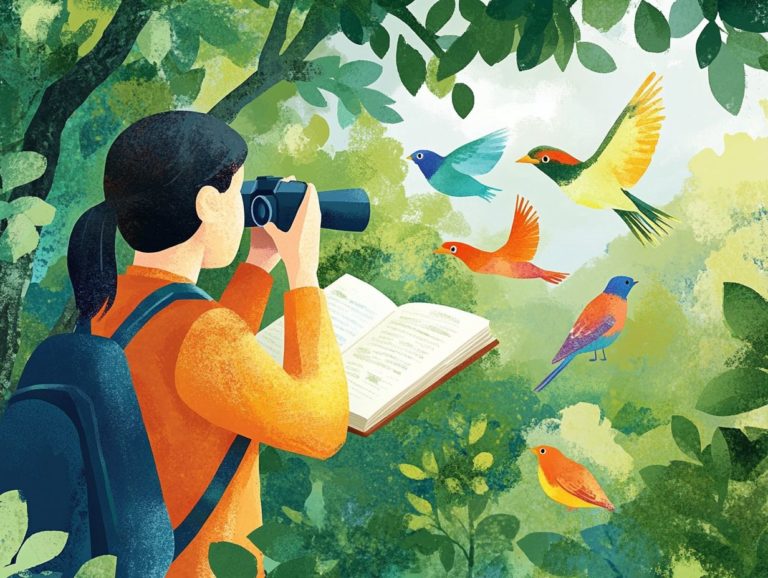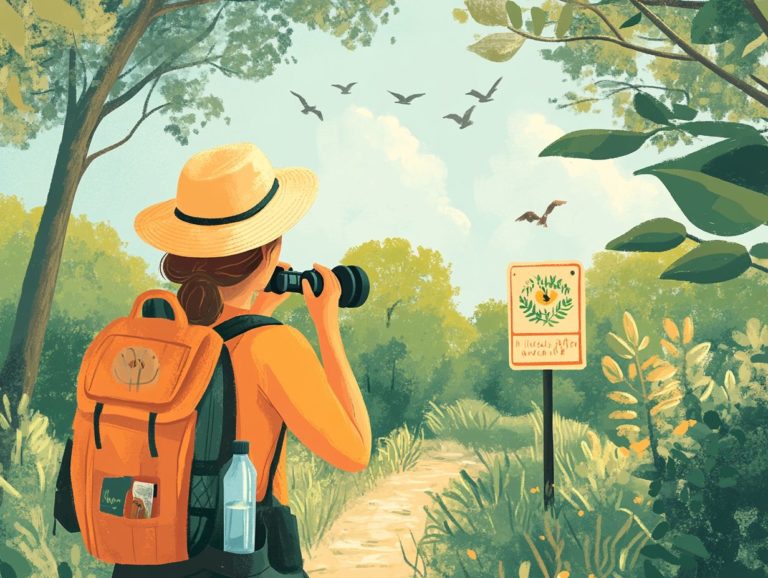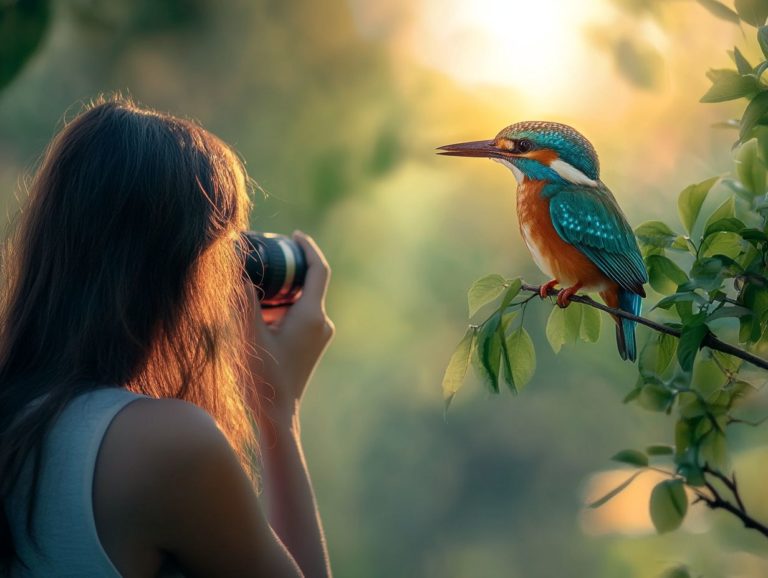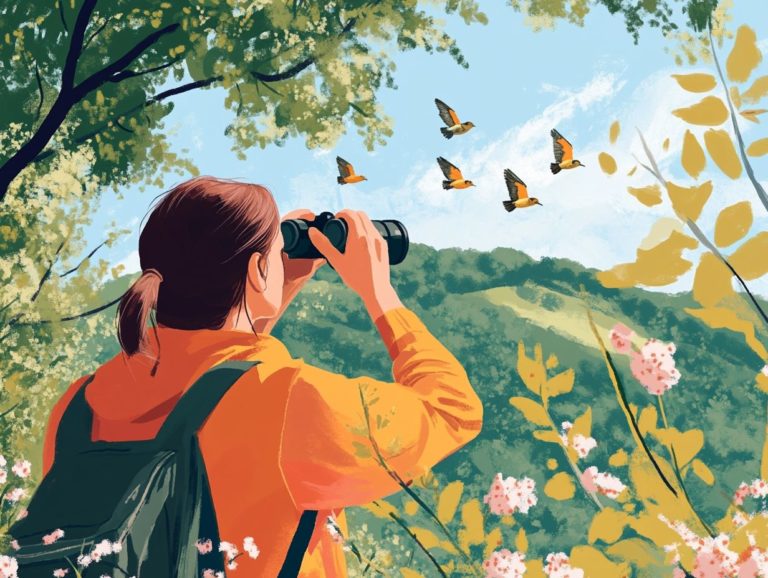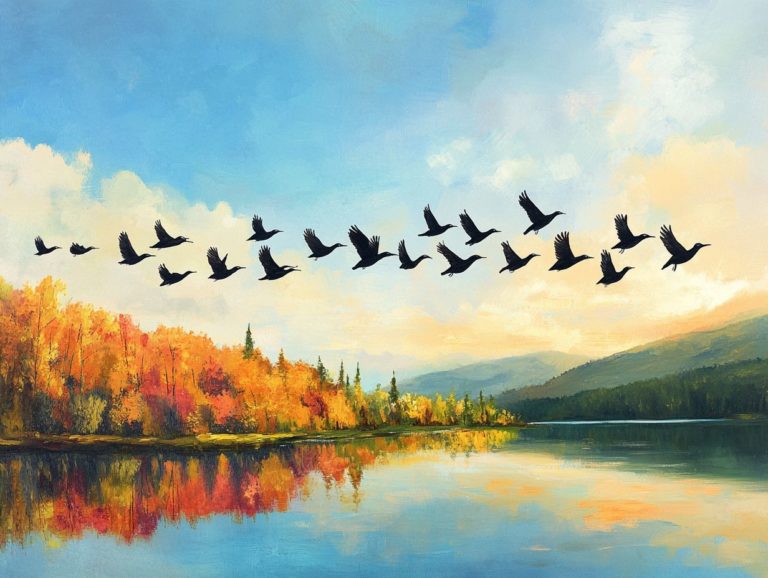How to Share Bird Watching Experiences Safely?
Bird watching presents a remarkable opportunity to connect with nature. However, it is crucial to prioritize safety and etiquette while immersing yourself in this fulfilling pastime.
In this article, you ll discover exciting safety tips for your outdoor adventures, highlight the benefits of sharing your bird watching experiences, and emphasize the importance of respecting both wildlife and fellow enthusiasts.
Whether you re an experienced observer or a curious newcomer, grasping these elements will enhance your journey and cultivate a deeper appreciation for the enchanting world of birds.
Contents
- Key Takeaways:
- Safety Precautions for Bird Watching
- Benefits of Sharing Bird Watching Experiences
- How to Safely Share Bird Watching Experiences
- Etiquette for Bird Watching
- Frequently Asked Questions
- What should I consider before sharing my bird watching experiences?
- How can I share my bird watching experiences without disturbing the birds?
- Is it safe to share bird watching locations publicly?
- What should I do if I encounter a rare or endangered bird during my bird watching experience?
- How can I share my bird watching experiences through photography without causing harm to the birds?
- What should I do if I see someone not following safe bird watching practices?
Key Takeaways:
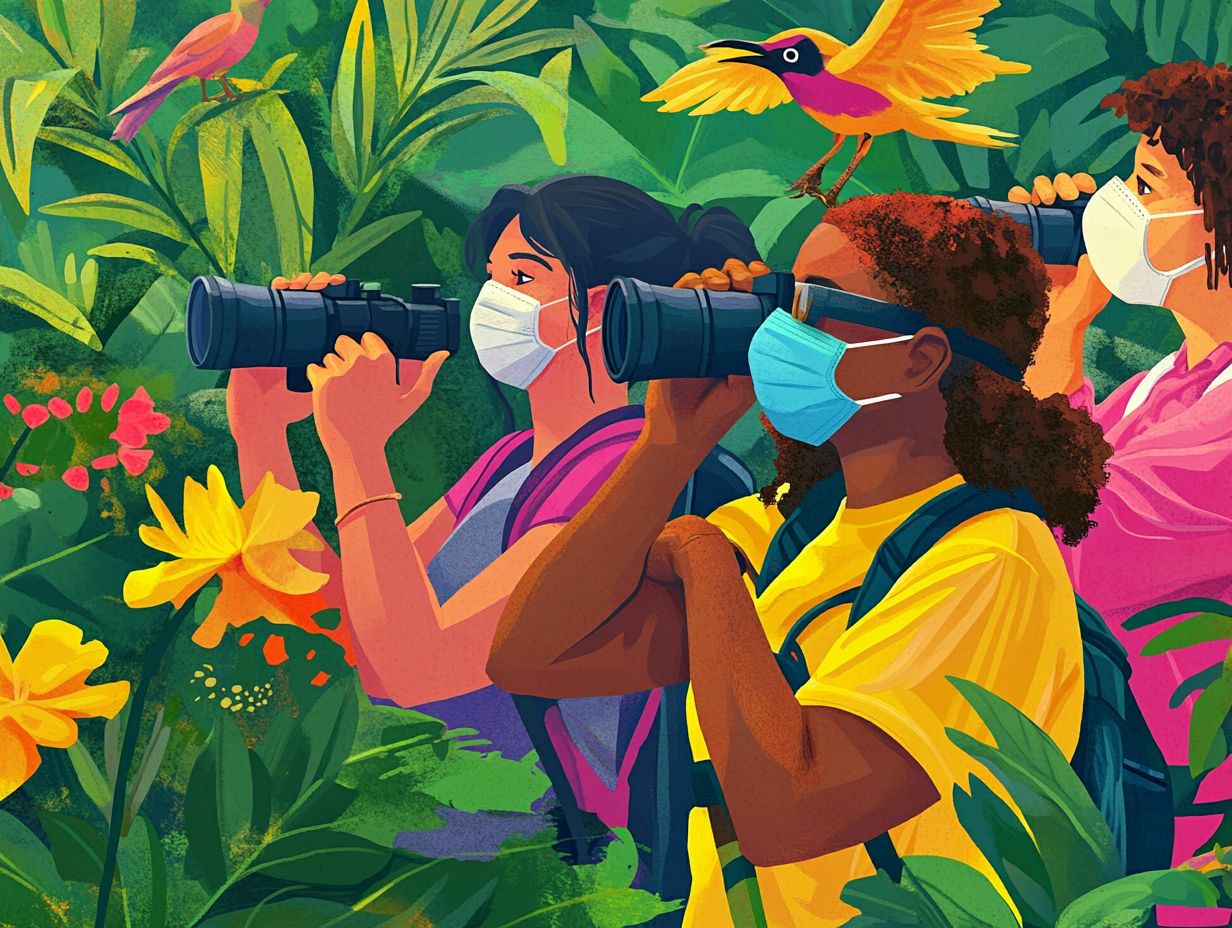
- Prepare for outdoor bird watching activities by dressing appropriately, bringing necessary gear, and informing someone of your plans.
- Share bird watching experiences through online platforms or organized events to promote community and conservation impact, as well as personal growth and enjoyment.
- Practice proper etiquette while bird watching by respecting birds and their environment, and being considerate of other bird watchers.
What is Bird Watching?
Bird watching, or birding as it s often called, is a delightful pursuit that invites you to observe and identify various bird species in their natural environments. With tools like binoculars and apps such as Merlin, you can immerse yourself in this engaging hobby.
Not only does it deepen your appreciation for nature, but it also plays a vital role in citizen science, which means ordinary people contribute to scientific research.
As you document your sightings and share your experiences perhaps at organized events hosted by local birding clubs or conservation organizations like Audubon New York and the Nature Conservancy you contribute to a larger movement.
The history of bird watching stretches back centuries, transitioning from a survival necessity to a beloved pastime that connects individuals with the natural world. Join the community and be part of this amazing adventure!
Resources like the Great Backyard Bird Count and the Merlin app have become invaluable, allowing you to contribute essential data while honing your identification skills.
Guides detailing specific bird species and their behaviors, including field guides and bird books, are must-haves for any birder. This community-driven hobby fosters a sense of camaraderie as enthusiasts exchange tips on effective techniques think bird calls and photography transforming each outing into a shared adventure of discovery.
Safety Precautions for Bird Watching
Keeping safe while bird watching is paramount for a truly enjoyable and rewarding experience. Whether you’re observing the wonders in your own backyard or exploring renowned birding destinations like Hawk Mountain or the Platte River, especially during hawk migration, adopting specific safety precautions is essential. Additionally, understanding bird watching ethics allows you to enjoy the activity responsibly while keeping safe.
By taking these safety measures, you can fully immerse yourself in the thrill of spotting delightful feathered friends, like the American robin or Lazuli bunting, or even waterfowl, all while safeguarding your well-being.
Preparing for Outdoor Activity
Preparation is essential for a successful bird-watching experience. Start by gathering the necessary tools think a field guide or a comprehensive bird book and a reliable pair of binoculars to elevate your observations.
By planning ahead and setting up bird feeders filled with black oil sunflower seeds in your backyard, you can significantly boost your chances of attracting a diverse array of bird species. This transforms your birding hobby into something truly enriching.
Choosing the right feeders is a game changer; a platform feeder is perfect for larger birds, while tube feeders are designed for smaller varieties, allowing you to appreciate a dynamic range of species.
Consider using a blend of seeds, like millet and thistle, to draw in different birds, and don t forget to position your feeders near natural cover this provides a sense of safety for your feathered friends.
Local wildlife centers and online forums can be invaluable resources for advice on the specific birds in your area. They can help you create an intentional setup that invites more visitors to your backyard, turning fleeting sightings into cherished memories.
Start your bird watching adventure today! Attract a variety of beautiful birds to your backyard with the right setup.
Interacting with Birds and their Habitat
Understanding bird habitats is essential for birdwatchers. It helps you appreciate their behaviors, from recognizing their songs to observing their feeding habits.
Engaging with local biodiversity enhances your birding experience. It also deepens your connection to conservation efforts aimed at protecting these remarkable creatures and their natural environments.
Using helpful apps like Merlin can significantly elevate your experience. These apps offer tools for real-time bird identification and insights into birds specific habitat needs. They empower you to contribute to community science projects, where everyday people help collect data for scientific research.
Join local bird counts or habitat restoration projects, such as those organized by the Nature Conservancy. Your participation helps preserve avian populations and cultivates greater awareness of your environmental impact.
Every bird you spot and sound you hear tells a story of ecological care. You become an advocate for your local ecosystems and their biodiversity.
Benefits of Sharing Bird Watching Experiences
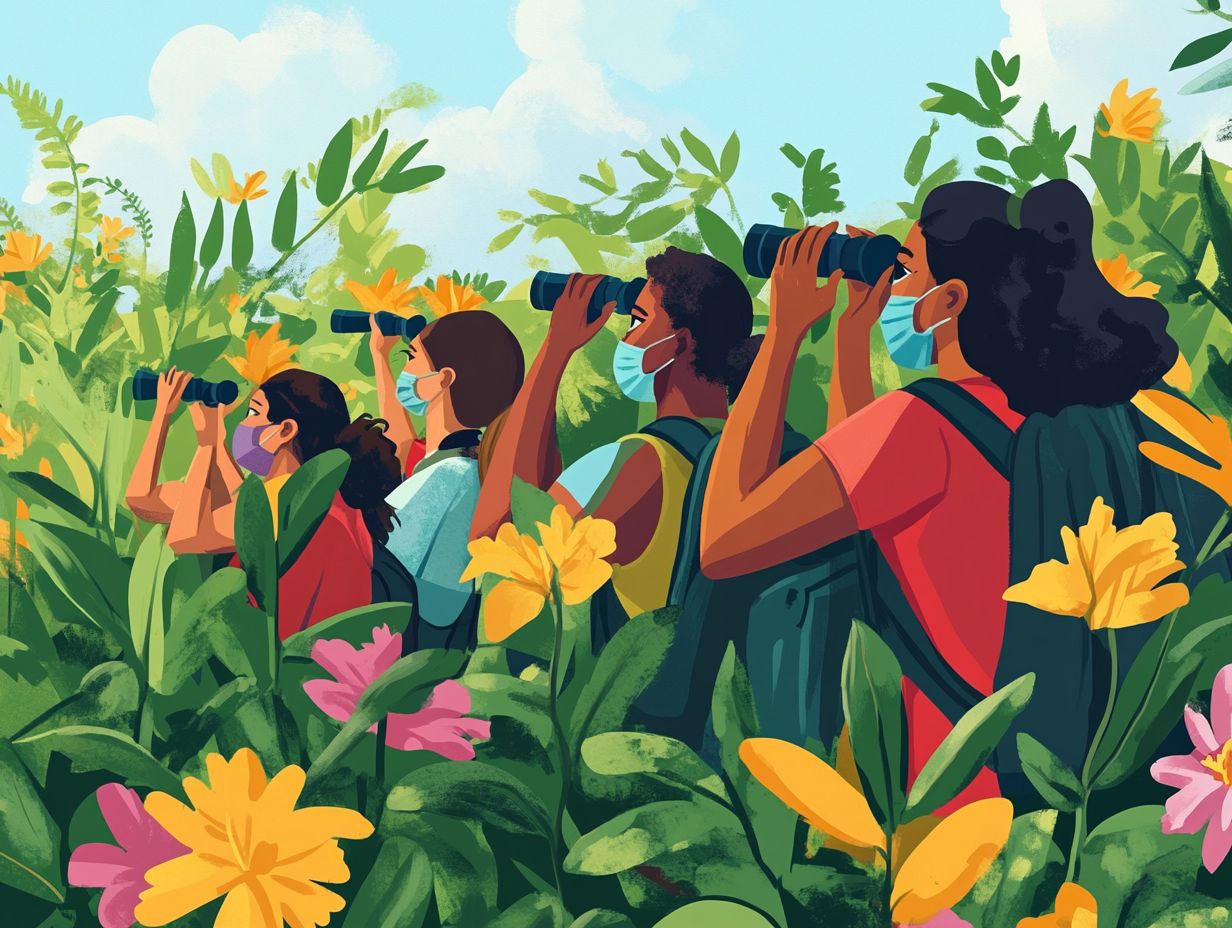
Sharing your bird-watching experiences offers a wealth of benefits that elevate your personal enjoyment. It also fortifies community connections and champions environmental conservation.
By exchanging your observations and insights with fellow birders, you play a vital role in community science projects like Project FeederWatch and the Great Backyard Bird Count. This collaborative spirit enriches your understanding and contributes to monitoring bird populations and their habitats.
Promote awareness through resources like Cornell Lab of Ornithology.
Community and Conservation Impact
The relationship between community and conservation in birdwatching is truly remarkable. Local birding clubs and organizations like Audubon New York play an essential role in raising awareness and safeguarding avian habitats.
By participating in community-driven initiatives, such as morning birding, you foster teamwork and inspire others to advocate for the protection of their natural surroundings.
Engaging in collaborative projects like habitat restoration, monitoring bird populations, and hosting educational workshops creates an enriching experience for enthusiasts of all ages.
When you get involved in initiatives like the Great Backyard Bird Count or local Clean-Up Days, you amplify the message of conservation. Forming partnerships with schools and local governments encourages broader participation and a deeper understanding of ecological balance.
Utilizing the strength of collective action, communities like yours can make a profound impact on local ecosystems, ensuring a sustainable future for both birds and people alike.
Personal Growth and Enjoyment
Engaging in bird watching fosters personal growth and enjoyment as you immerse yourself in nature. It enhances your observational skills and expands your knowledge of various bird species.
This rewarding hobby offers a unique opportunity to experience the tranquility of the outdoors and the thrill of spotting a rare bird in its natural habitat.
As you painstakingly observe your feathered friends, you may discover a heightened sense of mindfulness. This promotes mental well-being and alleviates stress and anxiety.
For instance, an avid birdwatcher might recall finding solace in a nearby park during tough times. The simple act of identifying a blue jay or woodpecker becomes a source of joy and grounding.
This passion nurtures emotional health and cultivates a profound appreciation for biodiversity and our environment, reinforcing the importance of conservation.
Each outing opens doors to learning about conservation efforts. It inspires you to become an advocate committed to protecting avian habitats, such as those found in the Pantanal. Enrich your personal development in multifaceted ways!
Sharing your birdwatching experiences with care can enrich your connection to the birding community while safeguarding your personal privacy. Whether you choose online platforms, social media, or participate in organized events, it’s essential to follow best practices, such as those outlined in how to share your birding adventures online, when sharing your sightings and photographs.
By doing so, you contribute to the collective knowledge and fully embrace the social joys of your passion for birdwatching.
Online platforms and social media have transformed how you share your birdwatching experiences. They allow you to connect with fellow enthusiasts and document your sightings in real-time, creating a sense of community among local birders.
Engaging in dedicated online birding clubs and websites lets you dive into discussions, showcase your photos, and exchange valuable tips about your favorite pastime.
These digital communities, like the Cornell Lab of Ornithology’s Bird Academy and platforms such as BirdWatching Daily or eBird, cultivate meaningful connections and provide essential resources for learning. You can participate in webinars, access expert articles, and contribute to community-based research efforts.
Dive into vibrant groups on Instagram and Facebook where you can share your birding adventures and connect with others who love birds just as much as you do! Each sighting can spark conversation and inspire others, creating an enriching environment.
By harnessing these tools, you can improve your skills, expand your knowledge, and truly feel a sense of belonging within a global community united by a shared passion for avian life.
Organized Events and Groups
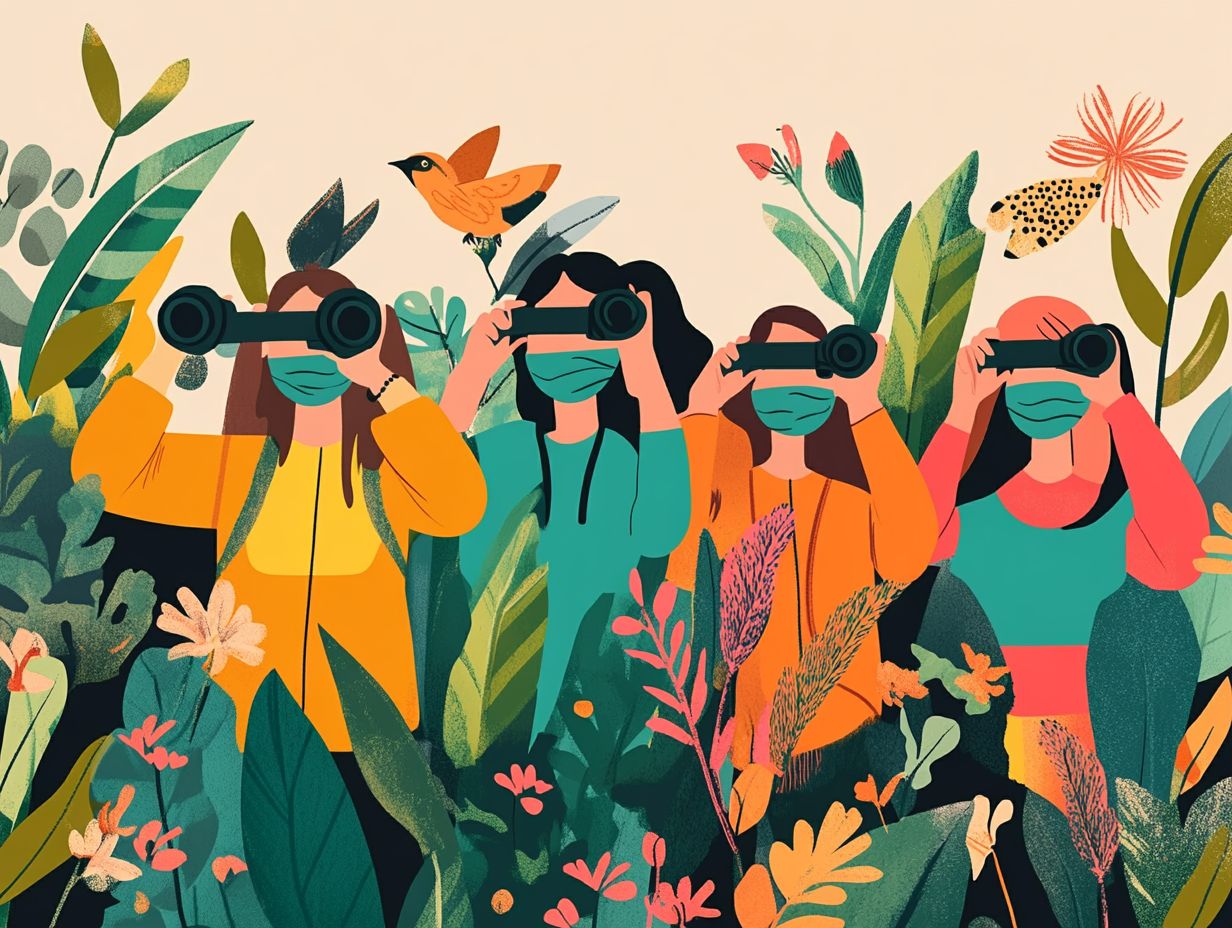
Participating in organized events and birdwatching groups can truly enrich your experience. These events offer opportunities to connect, learn, and contribute to conservation efforts. Local birders often come together for group outings, workshops, and festivals, all celebrating a shared passion for observation and the fascinating avian world.
These gatherings vary from casual bird walks hosted by local Audubon Society chapters to larger-scale birding festivals like the Great Backyard Bird Count. They provide valuable chances to exchange knowledge and techniques with fellow enthusiasts.
Don t miss out on the chance to join local birding festivals and workshops that celebrate our feathered friends! Attending these events not only sharpens your identification skills but also fosters a genuine sense of community among participants.
By collaborating with organizations such as the Cornell Lab of Ornithology, you can engage in community-based research efforts that contribute vital data for conservation. Ultimately, these organized events strengthen bonds within the birding community and promote a deeper appreciation for the rich biodiversity that surrounds us.
Etiquette for Bird Watching
Practicing proper etiquette in birdwatching is vital for safeguarding the well-being of birds and their habitats, while also cultivating a respectful community among fellow enthusiasts.
By following established guidelines, you can minimize disturbances to these feathered creatures and elevate the overall experience for yourself and others in the field.
Respect for Birds and Their Environment
Respecting birds and their environment is essential in birdwatching. It highlights the importance of observing without disrupting their natural behaviors or habitats. By engaging in responsible observation, you actively contribute to conservation efforts that aim to protect various bird species and their ecosystems.
This mindful approach helps you remain unobtrusive and underscores the importance of supporting organizations dedicated to habitat preservation, like the Audubon Society and BirdLife International. By maintaining a respectful distance, using designated trails, and avoiding feeding birds, you can significantly minimize disturbances.
Understanding seasonal migrations and nesting patterns allows you to plan your outings thoughtfully, ensuring you steer clear of critical breeding periods. Cultivating a profound appreciation for avian life serves as a powerful catalyst for broader environmental stewardship.
Consideration for Other Bird Watchers
Consideration for fellow bird watchers is crucial for etiquette. It fosters a harmonious environment where everyone can indulge in their shared passion for observing birds. By being mindful of other enthusiasts during organized events and outings, you help cultivate a positive community experience that enhances everyone’s enjoyment.
This means sharing prime viewing spots instead of competing for the best angle. Allow others the chance to enjoy the beauty of avian life. Keep your volume at a respectful level so everyone can immerse themselves in the sights and sounds of nature without distractions.
Adhering to established group protocols promotes unity and respect. This enables smoother communication and organization during larger gatherings. By embracing these practices, you contribute to an atmosphere that encourages personal fulfillment and nurtures the camaraderie essential to the birding community.
Frequently Asked Questions
What should I consider before sharing my bird watching experiences?
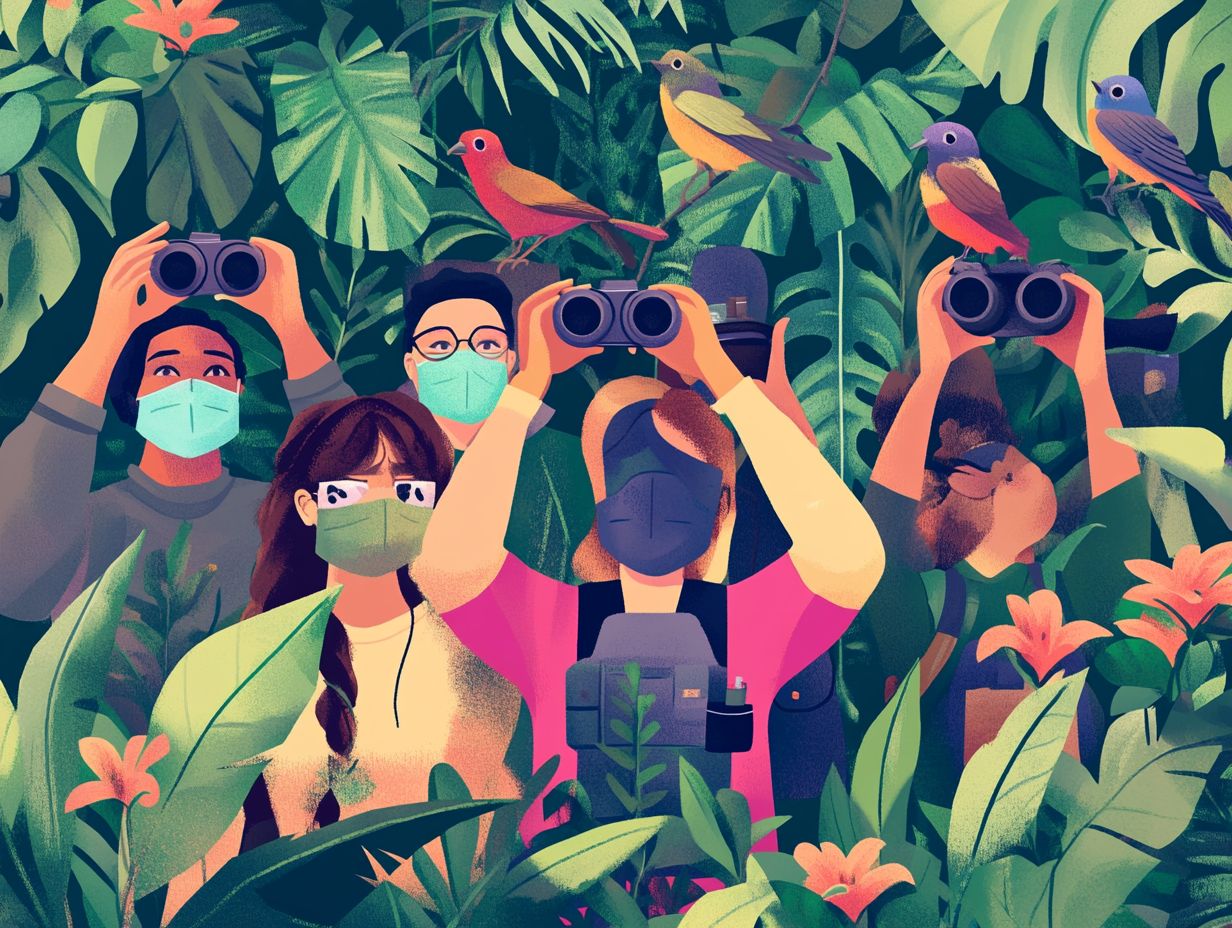
Think about the safety and well-being of the birds and their environment before sharing your birdwatching experiences. For tips on responsible birding, check out how to use apps for birdwatching safely, and always follow ethical birding practices while obtaining permission if necessary.
To share your bird watching experiences without disturbing the birds, maintain a safe distance, use binoculars or a telephoto lens, and avoid loud noises or sudden movements. For more tips, consider what to keep in mind when bird watching alone. Respect their natural habitat and do not enter restricted areas.
While sharing your bird watching locations can be exciting, consider the potential impact on the birds and their habitat. For those looking to enhance their experience, it’s best to follow best practices for bird watching by sharing general locations and avoiding specific nesting or breeding sites to prevent disturbance.
What should I do if I encounter a rare or endangered bird during my bird watching experience?
If you encounter a rare or endangered bird, keep your distance and observe quietly. Do not try to get closer for a better view or take photos. Report your sighting to the appropriate authorities to ensure the bird’s safety and well-being.
When sharing your bird watching experiences through photography, respect the birds’ space and avoid causing harm. Use a telephoto lens and do not get too close to the birds or their nests. Avoid manipulating their environment for a better shot.
What should I do if I see someone not following safe bird watching practices?
If you see someone not following safe bird watching practices, educate them politely about the potential harm they may cause to the birds and their environment. You can also share how to use binoculars for bird watching safely to offer helpful tips that improve their birding experience and lead by example to promote responsible and ethical birding practices.
Join our bird watching community and share your experiences!

